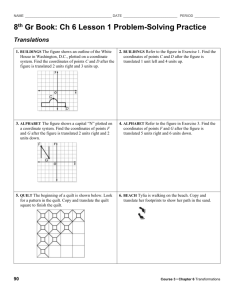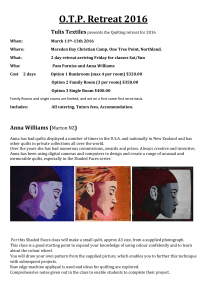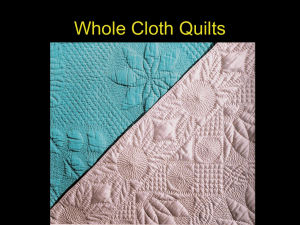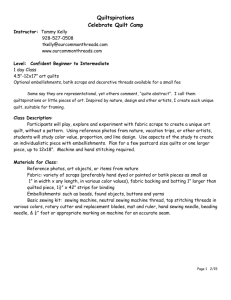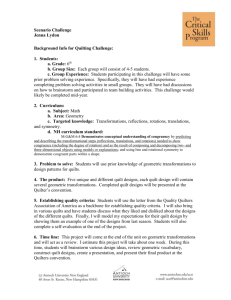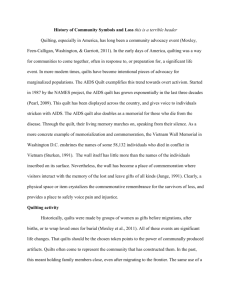Quilt Informational Packet
advertisement
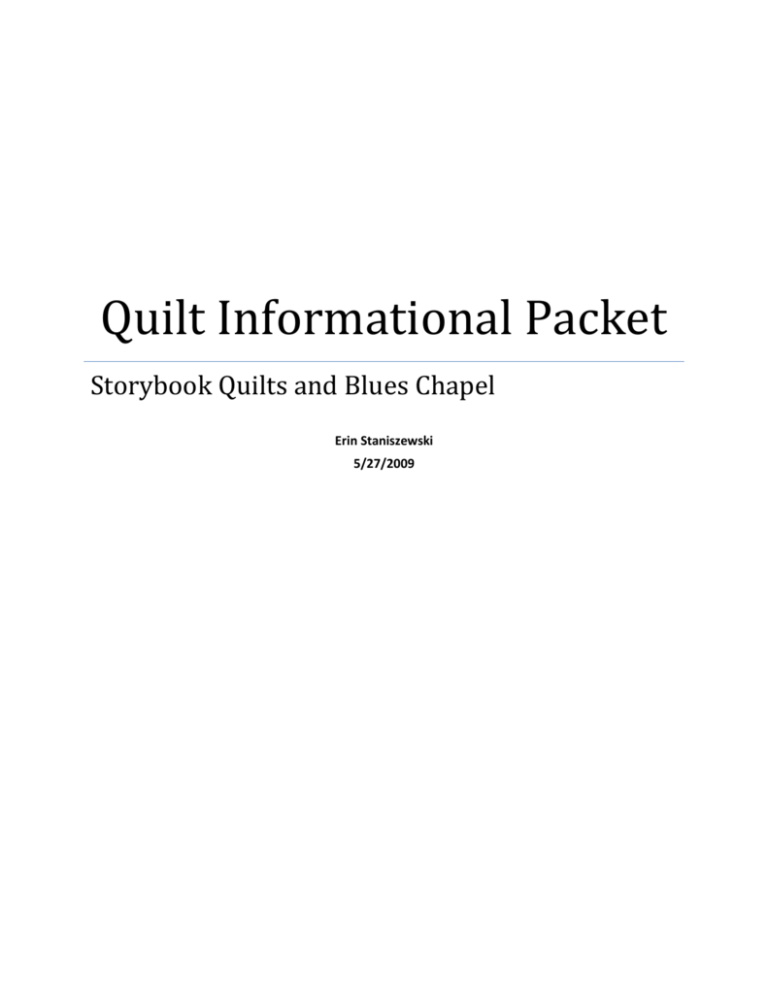
Quilt Informational Packet Storybook Quilts and Blues Chapel Erin Staniszewski 5/27/2009 Lesson Plans -Paper QuiltsIn this unit, students investigate fractional parts of the whole and use translations, reflections, rotations, and line symmetry to make four-part quilt squares. Teams of students make paper quilts from squares they have designed. Each team presents its quilt design to the class and describes how they arrived at the design. The teams analyze the different quilt designs and discuss the numerical and geometrical similarities and differences among them. There are many chances to integrate Social Studies and Art in this unit. Math Content Students will: -explore ways to divide squares into equal parts -use geometric and factional terms to name the parts of those squares -explore the results of translations, reflections, rotations, and line symmetry Individual Lessons Lesson 1 – Parts of a Square Students investigate the way shapes can be divided into equal pieces with one or two cuts. It provides a review of the following vocabulary terms: square, triangle, and rectangle; congruent, one-half, and one-fourth. The other lessons in this unit build on this introductory lesson. Lesson 2 – Describing Designs Students create designs and describe them to a classmate, using fractional and geometric terms. It provides a context for using the following vocabulary terms: horizontal, vertical, square, rectangle, triangle, diagonal, one-half, and one-fourth. Lesson 3 – Exploring Flips and Slides This lesson builds on the previous two lessons and encourages students to explore the geometric transformations of reflection and translation. Students create a design then, using flips and slides, make a four-part paper “mini-quilt” using that design as the basis. While the formal terms are reflection and translation, the more informal terms slide and flip are used at this stage. The experience focuses students’ attention on the changes these geometric transformations make in a student-designed quilt square. Lesson 4 – Exploring Turns This lesson encourages students to explore the geometric transformation of rotation. Students create a design then, using turns, make a four-part paper “mini-quilt” with that design as the basis. While the formal term is rotation, the more informal turn is used at this grade band. The experience focuses students’ attention on the changes the geometric transformations make in a student-designed quilt square. Lesson 5 – Analyzing Designs This lesson encourages students to explore the geometric transformation of rotation, reflection, and translation more fully. Students create a design then, using flips, turns, and slides, make a 4-part paper “mini-quilt” square with that design as the basis. This experience focuses students’ attention on both the changes produced by the geometric transformations and on line symmetry. Lesson 6 – Planning and Making a Mini-Quilt Students create a quilt using the three transformations and investigate the ways shapes can be colored to show onehalf and one-fourth. They locate lines of symmetry and create a set of directions for making their quilt block. -Additional information regarding individual lessons and other materials can be found at http://illuminations.nctm.org/LessonDetail.aspx?ID=U104 -Patterning in QuiltsMath Content Students will be able to: -use reasoning abilities to perceive patterns. -communicate mathematical ideas in a variety of ways, including words, numbers, symbols, pictures, charts, graphs, tables, diagrams, and models. -connect mathematical learning with other subjects, personal experiences, current events, and personal interest. -Use mathematics as a way to understand other areas of the curriculum (e.g., measurement in science, map skills in social studies) -describe two and three-dimensional figures (e.g., circles, polygons, trapezoids, prisms, spheres) by -Naming them -Comparing, sorting, and classifying them -Explaining how these figures are related to objects in the environment. Goal: Students will understand the use of the mathematic principle of patterning in quilt design. Objectives: 1) Students will be able to give a verbal definition of the word pattern. 2) Students will complete patterns started for them. 3) Students will create simple patterns using 2, 3, 4, and 4 colors and 2, 3, 4, and 5 shapes. 4) Students will use tolls such as a compass, ruler, protractor, and markers to design a quilt square using color and shape patterning. What is a pattern? A pattern is a repeated design of shapes and / or colors. The above pattern repeats three different shapes while the pattern below repeats the same shape, but in different colors. Blue Red Yellow Blue Red Yellow Blue Red Yellow Patchwork quilts are often based on patterns. A certain combination of shapes, colors, or fabric designs repeats to create the pattern. Here is a simple example: This quilt is made up of nine squares that alternate in color: in this case the colors are red, yellow, red, yellow, etc. In a quilt, this block might be combined with other 9-square blocks to create a pattern like you would find on a checkerboard. Another pattern can be found in the Grandmother’s Flower Garden quilt block. This pattern combines different colors or fabric designs of hexagons to create a flower shape. Can you complete the following pattern by filling in the colors? Create your own pattern using 2 colors. Next, try patterns of 3, 4, and 5 colors. Do the same using 2, 3, 4, and 5 shapes. Choose one of your designs to use on an 8” x 8” square piece of paper. Make the pattern as neatly as you can, using tools like a ruler, protractor, compass, markers, etc. Color the design with markers or crayons. After each student has created a design, post the quilt squares on a bulletin board to create a class quilt. Here is a list of shapes that students may choose to use in their quilt designs: Square Rhombus Rectangle Pentagon Circle Hexagon Triangle Octagon Parallelogram http://www.myhistorymuseum.org/documents/PatterningInQuilts.pdf Brief History of Quilting The art of quilting involves several different techniques. From around 1780 to the present, many quilters used the piecing technique to achieve beautiful quilts. Called Pieced or Patchwork Quilts, they were made out of pieces of fabric sewn together to make a specific design. Quilters use three layers of fabric when making their quilts. These three layers, the patchwork, insulation or batting, and the backing material are sewn together to create a finished product. Most popular from 1750 to 1850, quilters used the whole cloth technique. The Whole Cloth Quilt is made from one large piece of fabric that is embellished with quilting patterns and stitches. An additional technique for quilters is found using Appliqué. Extremely popular between 1775 and 1865, Appliqué involves using pieces of fabric, embroidery, or other materials that are then sewn onto another piece of fabric to create a design or pattern. With the onset of the civil war in 1861, women began to make quilts in order to make money to support the war efforts. They sent quilts to soldiers to keep warm and for other practical purposes. As quilting techniques continued to progress over the years, Crazy Quilts began to develop. The Crazy Quilt is made from a block of fabric that is assembled from irregular and often scrap pieces, the overall work had no set pattern or design. Popular in the late 1800s and early 1900s, quilters began to progress into the use of embroidery and embellishment to achieve the overall look of the quilt. With the establishment of Quilt Guilds in the 1920s, women began to join the social groups as a way to share projects and instruction with each other. The guilds were also able to support the pattern publication efforts that had begun in 1855. As patterns were collected and distributed amongst guild members, the traditional quilting techniques remained popular. However, as America transitioned into the 1960s, quilts became more popular as art pieces and began to lose their previous tradition of function. (www.womenfolk.com) (http://www.pbs.org/americaquilts/resources/glossaryF_L.html) (http://www.patternsfromhistory.com/civil_war/) Quilt Pattern Examples 9-Patch Civil War Prairie Queen Bearpaw Pattern Jacob’s Ladder
